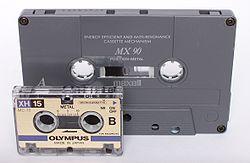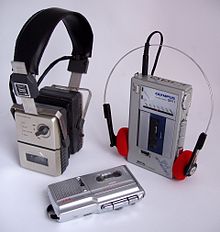- Microcassette
-
Microcassette 

A Microcassette is significantly smaller than a Compact CassetteMedia type Magnetic tape Encoding Analog signal Capacity MC60 (30 min per side at 2.4 cm/s)
MC15
MC30
MC90Read mechanism Tape head Write mechanism Magnetic recording head Developed by Olympus Usage Dictation, audio storage A Microcassette (often written generically as microcassette) is an audio storage medium introduced by Olympus in 1969. It uses the same width of magnetic tape as the Compact Cassette but in a much smaller container. By using thinner tape and half or a quarter the tape speed, microcassettes can offer comparable recording time to the compact cassette. The original standard microcassette, the MC60, gives 30 minutes recording per side at its standard speed of 2.4 cm/s, and double that duration at 1.2 cm/s; an MC90, giving 45 minutes per side @ 2.4 cm/s, is also available from a few manufacturers. Unlike the Compact Cassette, a choice of recording speeds was provided on the original recorders and many others; the tape also spools in the opposite direction, from right to left. For transcription purposes, continuously variable speed was provided on many players.
Microcassettes have mostly been used for recording voice. In particular, they are commonly used in dictation machines and answering machines. However, Microcassettes have also been used as a medium for computer data storage, and as a medium for recording music. For the latter purpose, devices for recording in stereo were produced in 1982 and, for higher fidelity, microcassettes using Type IV ("metal", i.e. coated with pure metal particles rather than oxide) tape were sold. This was an attempt by Olympus to cash in on the burgeoning Walkman market; one model, the Olympus SR-11, even had a built-in FM tuner and offered a stereo tie-clip microphone as an accessory, which made the unit somewhat popular with concert-goers who wanted to record the concerts they attended without drawing attention to themselves with larger, bulkier full-sized cassette recorders. Unfortunately, both these "high-fidelity" microcassette recorders and the special Type-IV blanks they required were relatively expensive and of limited availability, so the system was not widely adopted and Olympus phased them out after only 2 years on the market. (Battery life was also a problem, since the relatively high bias currents required by Type-IV tape, combined with the state of battery technology at the time, meant that even a brand-new pair of alkaline batteries might give out in as little as 2 hours when the unit was in recording mode.)
Comparable products to the microcassette include the minicassette, produced by Philips, and the picocassette, produced by Dictaphone. Of the three formats, the microcassette was the most common. In 1992, Sony released the NT memo recording system which employs a small cassette, but records digitally.
Microcassettes' equalization time constant is undefined but it should be lower than cassettes.
See also inches per second and audio tape length and thickness for comparisons with other media.
In popular culture
- In the Saw series of films, the Jigsaw Killer uses microcassettes as one means of delivering information to his victims. Often, a recorder is found with a tape already loaded into it; other times, the tape is found separately and labeled "Play Me."
- In Transformers, many robots, including Rumble, Laserbeak, Ravage, and Steeljaw are able to transform into microcassettes.
- A prerecorded microcassette containing Beethoven's Symphony No. 9 (bearing a Deutsche Grammophon label) and a hi-fi microcassette deck, are seen in Stanley Kubrick's film A Clockwork Orange.
- On the Take On Me episode of Degrassi: The Next Generation, Ellie Nash has a microcassette recorder in her bag and records many of her conversations with the other students in detention, mainly Sean Cameron.
- In the movie WarGames the character David Lightman uses a microcassette recorder to record the sounds produced by the door lock panel; he then plays the recording back to unlock the door and escape the infirmary at the NORAD facility.
- In the cult television series, Twin Peaks Special Agent Dale Cooper frequently records his observations and thoughts concerning everything from murder to cherry pie upon a microcassette recorder.
External links and references
Categories:- Audio storage
- 1969 introductions
Wikimedia Foundation. 2010.


